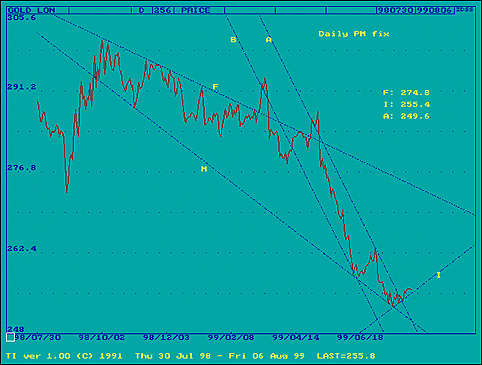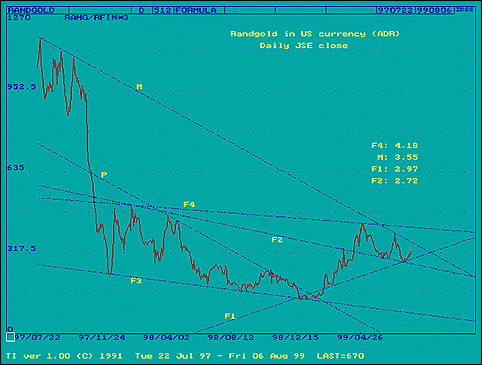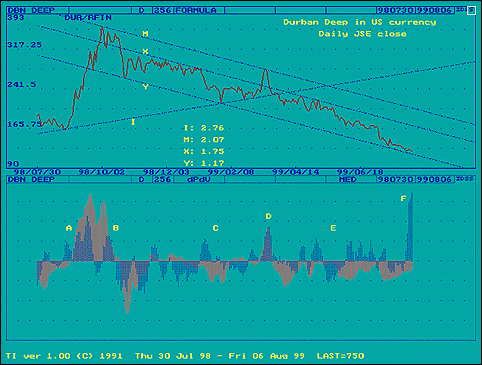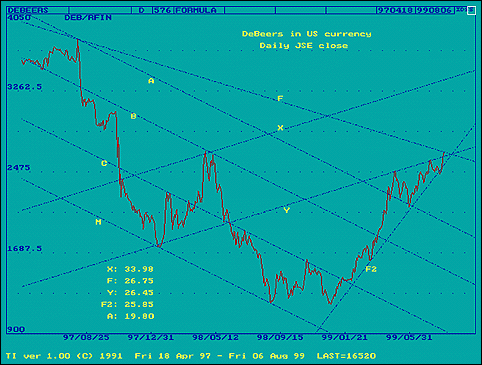Chart Symmetry
Daily Gold Price; Randgold; Durban Deep; DeBeers
Chart Symmetry is designed around the observation that prices tend to change direction along certain preferred gradients. New readers are advised to read the first article in this series to discover how Chart Symmetry works. The link to this article is:
https://www.gold-eagle.com/south_africa/regional_analysts/joubert020699.html
The prices shown for the lines are the values of the lines at the next time interval after the chart close. It is not a prediction that the price will suddenly move to reach that line overnight, but provides the reader a measure of the move that could take place if the price pattern does develop in the direction of that trend line. The steeper the line, the greater will be the change in the line value over time.
The key point to remember throughout is that the gradients of all secondary lines were derived from the gradient of the master line. The scope for the analyst to 'do his own thing' and develop a pre-conceived pattern is therefore quite limited. The patterns that are shown in the analyses are inherent in the charts, but these are not the only patterns that can be derived.
Gold Price. Daily PM fix. (Last = $255.80)
Three formations can be identified on the chart – bear channel, B-A, large megaphone, F-M, and a steeply descending wedge, M-A.

As usual, the gradients of the additional lines on the chart were derived from the gradient of the master line, M. I is the inverse of M, line F is a shallower derivative and A-B is a steeper derivative of M.
While there are the two penetrations above F – just at the time when a rising POG was hammered by intervention from official quarters! – the presence of F as a substantial trend line is justified in this analysis from what happened along line F during the shallow bear trend between October 1998 and May this year.
Wedge patterns typically require 5 legs to be completed, which is what happened here. If the early penetration of line A is disregarded and taken as the end of leg 1, it is clear that the wedge completed leg 5 recently and then hesitated a little before the final break higher through line A. It now seems set to follow support along line I.
Scenario 1: The POG breaks lower through support at line I to resume the bear trend.
Scenario 2: Support along line I holds and POG sooner or later responds to the presence of megaphone F-M with a sharp and volatile move higher to test resistance at F again.
Preference: Scenario 2 – but only while support along line I holds. Megaphones tend to contain sustained and quite steep trends, so that a sharp move higher to line F in the not too distant future would be in character for the chart formation.
Randgold in US currency (ADR). Daily JSE close. (Last = $3.26)

Randgold's ADR price is caught in a narrowing formation between some substantial support and resistance lines. When a break from here takes place in due course, it is expected to set a new trend.
The derived lines in this analysis are of interest as they span five orders of derived lines, from line P, parallel to M, then F1, first shallower derivative of M through to F4, the fourth derivative.
Formations of interest include megaphones F4-F3, and more recently F4-F2, and triangles M-F1 and F4-F1. M-F3 is a large descending wedge of which leg 3 had just commenced. The price is already on the fourth legs of the two triangles, which would require a move to either line M or line F4 to complete the appropriate leg and meet significant resistance.
Scenario 1: The price reaches and reverses direction at line M. The new bear trend breaks below F1 and falls until support at F3 is reached..
Scenario 2: The price breaks through resistance at line M to complete leg 4 of the triangle F4-F1, reaching strong resistance at line F4.
Preference: The key to the two Scenarios lies with POG. With POG assumed to increase further, as per the above analysis, and given that F4-F3 is the current consolidation pattern, a move to reach and test resistance at line F4 is anticipated. The key to what is likely to happen will be supplied when the price of the Randgold ADR reaches resistance at line M, currently at $3.55. A break higher will be bullish; failure to break higher soon after will signal a reversal down to F1 or even F2, at best.
Durban Deep in US currency. Daily close. (Last = $1.22)

It was mentioned in earlier reports that the bull market of late 1998 ran into heavy profit taking and the dollar price of Durban Deep subsequently entered a gradual bear trend, contained in the lower two-thirds of bear channel M-Y. The bear trend was confirmed when the price broke downwards from triangle M-I, through support at line I, on the fourth occasion of that support line being tested. Line I is a shallower inverse derivative of line M.
The lower chart shows a dPdV® volume analysis for DRD, using JSE turnover figures. Blue bars are the turnover or volume MACD; pink bars are the price MACD. Readers who are unfamiliar with this indicator can refer to the article at this link: https://www.gold-eagle.com/south_africa/regional_analysts/joubert042099.... for information on how the indicator is generated and interpreted.
The sharp increase in demand at A (blue MACD bars rising steeply) started a rally that topped out on substantial profit taking (B). Sporadic instances of buyer interest (C-D) only helped to steady the decline in the price, until a rapid increase in demand (on rising POG) caused the price to spike higher (at D). Failure in the POG then cut the legs from below Durban Deep and the price failed to react to any degree to subsequent instances of rising demand (E).
The sustained decline in the price between D and F despite occasions of good increase in demand – blue bars above the base line – can be interpreted as being due to large supply that is dumped onto the market the moment buyers become interested and the price shows an inclination to increase. Possible reasons for such behaviour, if the interpretation is correct, are not known.
Now, at F, with the ADR price close to significant support at line Y, the recent steep rise in the turnover on the JSE may well be a warning that buyers have taken to Durban Deep as a good prospect to accumulate.
What happens to the turnover and what happens to the gold price this week of August 13th will provide an early pointer to the future behaviour of the price.
Scenario 1: Turnover increases even more - early warning confirmed! – and the price MACD (pink bars) also breaks upward through the base line to confirm. The price recovers (perhaps only after a brief spike lower to reach line Y?) and then begins a new rising trend to test resistance at the top of the bear channel at line M.
Scenario 2: Supply remains high and satisfies all new buyer demand that is evident from the spike in the turnover MACD. When demand is fully quenched, the price breaks below support at line Y to continue the bear trend.
Preference: With POG in a rising trend and with the ADR price very near to medium term support, the selection must go for Scenario 1. If weakness is to continue until support at line Y at the bottom of the bear channel is tested, that would probably have to happen within the next few days. Any rebound now, initially at least still on high turnover, will be bullish.
DeBeers in US currency. Daily. (Last = $26.76)
The daily chart of the ADR price of DeBeers uses the same master line that was used for the first analysis early this year. The price has broken upwards from the overall bear channel, A-M, and then gave a classical goodbye kiss on A before resuming the rising trend – briefly breaking below support at line A on both the first small correction and the quite substantial goodbye kiss that followed.

The price closed on Friday at key resistance from the upper boundary of megaphone F-M, where line F is the shallower derivative of master line M. What happens here is likely to determine the near to medium term trend.
Another important formation is the rising wedge, Y-F2. The count of the legs in this pattern is not clear, as the price did not reach support at F2 at what might have been the end of leg 3 of that wedge. The break upwards through resistance at line Y is therefore taking place either at the end of leg 4 or of leg 6. The difference is mainly academic if the price now breaks above line F too, to continue the rising trend, since the break from the wedge on either count would be very bullish – taking place on an even numbered leg and not leg 5 as would normally be the case.
Scenario 1: The price breaks above resistance at line F to extend the bull trend and sooner or later reach resistance at line X.
Scenario 2: Resistance at line F holds firm and the price rebounds to break back into and later below wedge Y-F2. Bearish, with line A as the first significant level of support.
Preference: Given the break above resistance at line Y, Scenario 1 is preferred until – and if – the price breaks back below the top of the wedge at line Y.
Previous charts:
US 30-year T-bond: The yield has again reached strong market support on its weekly chart, closing just a fraction above the support level at 6.125%. Any further weakness would be very bearish, but the possibility of a rally to 5.96% by Friday to complete leg 4 of a triangle is a possibility. A close on Friday below 5.96% would be bullish for the near term. A definite break above 6,125% by Friday would have 7% as medium term target.
















